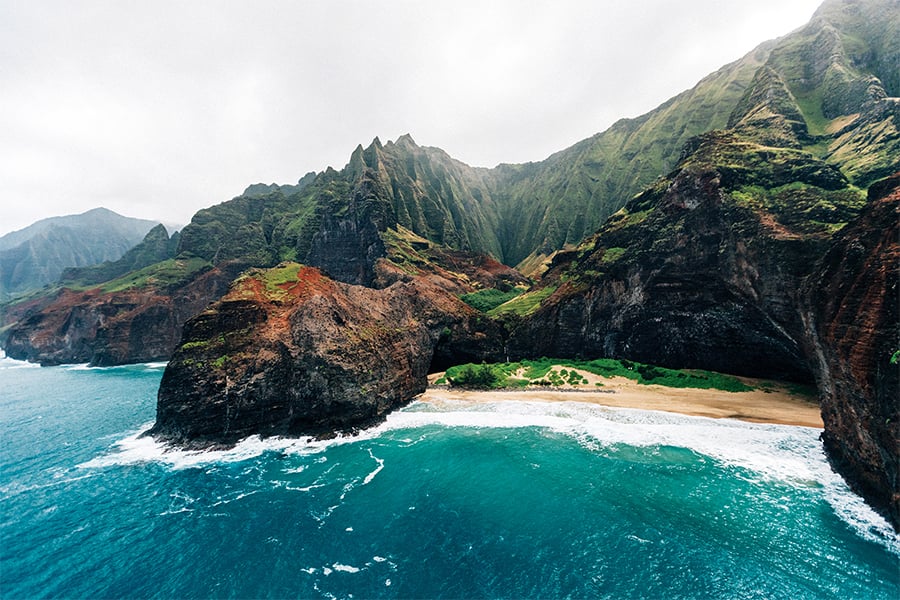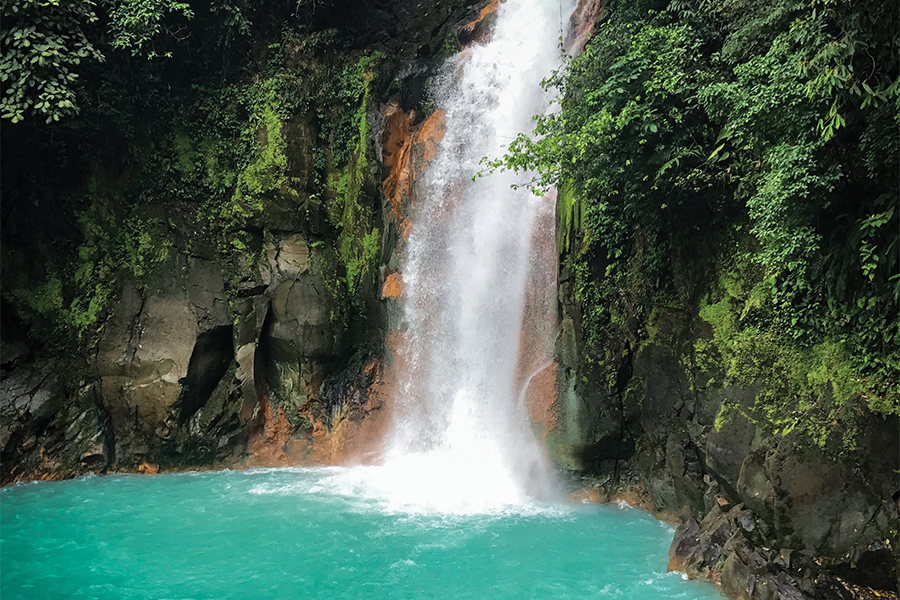Delightful Finds in the Hawaiian Islands

From flower leis and late-night luaus to surfing lessons and hula demos, the beloved Aloha State offers travelers traditional experiences unlike anywhere else in the United States. Hidden beaches, wondrous marine life and a centuries-old Polynesian culture mean limitless opportunities to make discoveries of your own—and great memories to last a lifetime.
Hawaiian Scenery
The Simply Spectacular
Driving along Kuhio Highway on Kauai’s north shore, idyllic scenes of crashing waves and swaying palm trees are mesmerizing to visitors, especially mainlanders who rarely see the ocean. Yet just past the town of Princeville is the Hanalei Valley Lookout, a must-stop to view the island’s lush, mountainous interior, where miles of taro fields are quenched by sunshowers, and frequent rainbows enhance postcard-worthy images. Unhurried travelers should make time for a drive a few miles farther into the valley to visit the 917-acre Hanalei National Wildlife Refuge, where a habitat of 50 bird species nest and feed in the flat river valley and surrounding wooded hillsides.
Sunset Beach on Oahu’s north shore comes highly recommended for capturing breathtaking scenery in the waning daylight. But equally alluring is the crowd-gathering spectacle in December and January, when elite surfers compete on massive waves rolling in from the north Pacific Ocean. The north shore’s laid-back vibe is a refreshing contrast to the frenetic energy of Honolulu, and it’s easy to reach by car, local bus or—strongly recommended by travel advisors—an organized day trip that can include relaxing beach time, a waterfall hike, zip lining and even time for gallery-browsing. Water activities like paddle boarding and kayaking are restricted to summer months when the sea is calmer.
....and the Weirdly Wonderful
The famous all-day “Road to Hana” drive on Maui’s northeast coast features awe-inspiring scenery at every turn, but there’s a reward for pulling over just past mile marker 7—a nearly hidden grove of rainbow eucalyptus trees known as the Painted Forest. These fast-growing specimens can reach 200 feet tall, providing a cooling canopy of rainforest shade and an invisible mist of aromatherapy. But it’s the technicolor streaks along the trees’ trunks that give the forest its name. In their annual shedding process, the new bark initially appears with a greenish hue, then gradually deepens to overlapping shades of red, blue, orange and pink. Not your average eucalyptus variety, this species appears in other parts of North America but thrives best in tropical rainforests.
Near the southern tip of the island of Hawaii (known as “the Big Island”) and in a bay formed long ago by volcanic eruptions is Papakōlea Beach, one of just four green sand beaches in the world. Its color comes from olivine, a common mineral found in lava which crystalizes as the liquefied rock just beneath the earth’s surface cools. Being denser than the remaining volcanic ash, olivine accumulates on the beach over time as the ash gets washed away, creating the amazing spectacle we see today. Papakōlea Beach is not easy to reach; it’s about a two-hour drive from either Kona or Hilo, and a 2.5-mile downhill hike* that is appropriate only for active travelers wearing proper footwear.
*Editor’s Note: The road down to the beach is off limits to vehicular traffic, so any unlicensed shuttle drivers offering rides should be avoided.
Foodie Favorites in Hawaii
This eatery isn’t exactly hidden but it’s a gem. Locals and tourists alike flock to Marukame UdonWaikiki for fresh noodles, tempura, curry and other Japanese delicacies so utterly irresistible, many confess to returning for more the very next day. Located just behind the famous International Market Square a few blocks from Waikiki Beach, it’s easy to find—and while the lines are long, they move quickly. Once inside, patrons nosh on classic dishes like made-to-order udon noodles, teriyaki bowls tempura—and this surprise hit—SPAM wrapped up in a crispy spring roll.
Snow cone connoisseurs from the mainland can take it up a notch with the tantalizing variations of shaved ice found throughout the islands. One Kauai standout, The Fresh Shave, serves its all-natural, organic version out of a vintage trailer located “under the big Monkey Podtreein Old Koloa Town,” according to the company’s website. The desserts are barbershop-themed works of art, piled high with locally sourced ingredients like Kauai honey, acai berries, pineapple, coconut and chia seeds. Kids love the straws adorned with take-away mini mustaches.
Hawaiian-style comfort food, friendly service and a solid endorsement from locals is what makes The Big Island Grill in Kona such an appealing dining option. Loco Moco, a regional dish featuring white rice smothered by a fried egg, gravy and your choice of assorted meats(including hamburger, shrimp, roast pork, corned beef hash patties and yes, SPAM) is the hot item, but everything from waffles to shredded pork with cabbage and fresh-catch fish and chips earn rave reviews. This popular restaurant is open for breakfast, lunch and dinner.
Precious Hawaiian Wildlife
Early morning tee times and coastal dune walks might be rewarded with a nene (aka Hawaiian goose) sighting, and while this might mean little to the average vacationer, birders are thrilled at the possibility. The nene is the state bird of Hawaii and is the world’s rarest goose. Zoologists believe there might have been around 25,000 Hawaiian geese living on the islands in the 1800s, but the number fell to just 30 birds by 1952, when a breeding program was launched to help them recover. Today, around 2,500 nenes spend most of their lives foraging for berries, fruits and flowers on the grass and pastureland of five islands—Maui, Kauai, Hawaii, Molokai and Oahu. The birds rarely fly, and their unique coloring (dark plumage and diagonal black stripes along the neck) make them easy to spot.
The Hawaiian monk seal is one of just two living species of monk seals left on Earth. Saving these beloved creatures (named for their bountiful folds of fur around their necks, like a monk’s cowl) is a major conservation initiative. Only about 1,400 Hawaiian monk seals exist today, breeding mainly in the northwestern Hawaiian Islands and resting on the larger main islands’ less crowded beaches. The best way to see them is on a private tour—check out Learn HawaiianMonk Seal Tours on Oahu, and book ahead through a AAA Travel Advisor, as these are regular sellouts.
It’s not an easy life for the Hawaiian green sea turtle (locally known as honu), but for the lucky and strong, it can be a long one. After reaching maturity at around 25 years of age, most females will make their way every few years to the northern Hawaiian Islands—a journey of up to 600 miles—where they lay their eggs just below the sand on secluded beaches. Under the watchful eyes of predators above, tiny hatchlings make a mad dash to their new home in coastal tide pools and the open ocean where they’ll spend much of their early years in search of food.
Hawaiian green sea turtles are not endangered, but they are listed as a threatened species due to sharks, domestic animals, crabs and occasionally, people (who don’t realize that touching or harassing them is against the law). Perhaps their greatest threat is the condition of the ocean itself, bogged down with debris and a shoreline increasingly impacted by higher sea levels. If interested in viewing these awe-inspiring marine animals, snorkel tours offer abundant opportunities to view them from a safe distance. Two fine options are Turtle Town on Maui’ssouth shore and boat tours to Turtle Canyon off the coast of Oahu near Waikiki Beach. Or you might just get lucky—honu can be sometimes spotted throughout the islands sunning themselves on beaches or swimming nearby offshore.
Authentic Hawaiian Entertainment
As one of the few states that was once an independent nation, Hawaii was ruled for centuries by monarchies. When Hawaii’s King Kamehameha II came to power in the early 1800s, he decided it was time to modernize. One of the first religious taboos he removed was the rule that men and women couldn’t eat together, and thus was born the great Hawaiian party (for all) known as the luau.
Today, luaus celebrate Hawaiian traditions with music, dance and of course, lots of great food. Guests typically dine on roasted pig, cold salmon, poke (diced raw fish), Poi (mashed starchy vegetables, usually taro root) and a hearty assortment of dishes from the melting pot of nations that has influenced Hawaiian cuisine. Portuguese sweet bread rolls, Japanese shoyu chicken, Canadian beef dishes and even macaroni salad are regular features at the dining table. But it’s the entertainment that leaves a lasting impression—traditional hula, Samoan fire-knife dances, spear throwing and even ukulele lessons capture the Aloha spirit in an authentic way that few other events can.
Luaus come in all varieties and are offered on all five main islands. They range from upscale affairs at luxury hotels to backyard barbecue-style gatherings. One might feature solo musical performances and lively storytelling, while another will include state-of-the art media with choreographed dance productions. It makes sense to research options carefully and enlist the help of a travel professional who will likely make a recommendation to reserve the best seats you can—it’s worth it for an unforgettable view of something you won’t see anywhere else.
Ready to plan your vacation? Start by enlisting the services of a trusted AAA Travel Advisor who can provide options that best fit your needs, from airfare and accommodations to authentic experiences. AAA Travel customers also receive assistance navigating the complexities of COVID-19 protocols and testing requirements.





